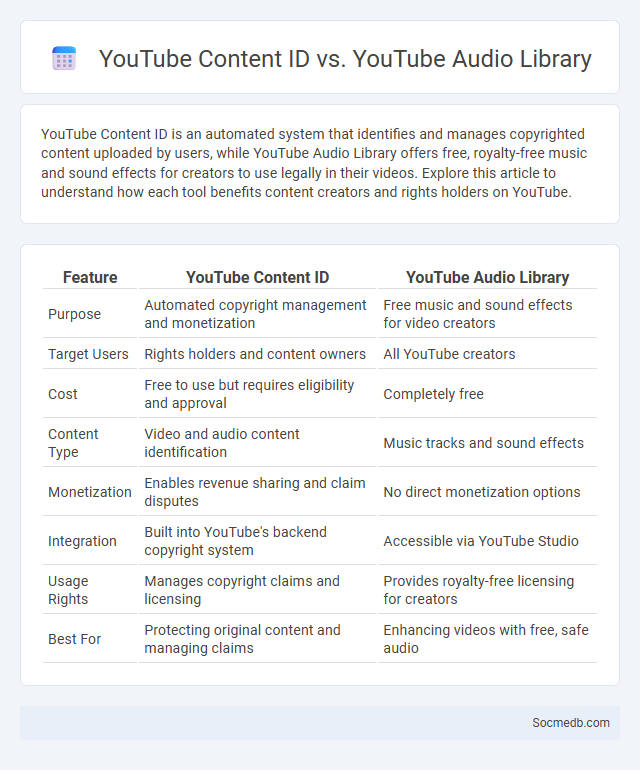
Photo illustration: YouTube Content ID vs YouTube Audio Library
YouTube Content ID is an automated system that identifies and manages copyrighted content uploaded by users, while YouTube Audio Library offers free, royalty-free music and sound effects for creators to use legally in their videos. Explore this article to understand how each tool benefits content creators and rights holders on YouTube.
Table of Comparison
| Feature | YouTube Content ID | YouTube Audio Library |
|---|---|---|
| Purpose | Automated copyright management and monetization | Free music and sound effects for video creators |
| Target Users | Rights holders and content owners | All YouTube creators |
| Cost | Free to use but requires eligibility and approval | Completely free |
| Content Type | Video and audio content identification | Music tracks and sound effects |
| Monetization | Enables revenue sharing and claim disputes | No direct monetization options |
| Integration | Built into YouTube's backend copyright system | Accessible via YouTube Studio |
| Usage Rights | Manages copyright claims and licensing | Provides royalty-free licensing for creators |
| Best For | Protecting original content and managing claims | Enhancing videos with free, safe audio |
Introduction to YouTube Content ID and YouTube Audio Library
YouTube Content ID is an advanced digital fingerprinting system that helps copyright owners identify and manage their videos on the platform, enabling claims, monetization, or tracking of unauthorized use. The YouTube Audio Library offers a vast collection of royalty-free music and sound effects, allowing creators to enhance their videos while avoiding copyright strikes. Both tools are essential for maintaining compliance and optimizing monetization strategies on YouTube.
What is YouTube Content ID?
YouTube Content ID is a digital rights management system designed to help copyright owners identify and manage their content across YouTube. By scanning uploaded videos against a database of registered files, Content ID automatically detects matches and allows rights holders to monetize, track, or block unauthorized use. Your ability to protect and control your intellectual property on YouTube is enhanced through this powerful system.
What is YouTube Audio Library?
YouTube Audio Library is a free resource offering a vast collection of royalty-free music and sound effects for content creators. It provides tracks in various genres and moods, allowing seamless integration into videos without copyright issues. Users can filter selections by duration, attribution requirements, and genre, ensuring tailored audio choices for YouTube projects.
Content ID vs YouTube Audio Library: Core Differences
Content ID on YouTube is an automated system that identifies copyrighted material in user-uploaded videos, allowing rights holders to claim revenue or block content. In contrast, the YouTube Audio Library provides a collection of royalty-free music and sound effects that creators can use without fear of copyright claims. While Content ID enforces copyright protection across the platform, the Audio Library serves as a resource for safe, legal audio content creation.
How Content ID Works: Rights Management Explained
Content ID uses advanced digital fingerprinting technology to scan uploaded videos for copyrighted material, comparing them against a database of reference files provided by rights holders. When a match is detected, the system automatically enforces rights management policies, such as monetization, blocking, or tracking of the video's usage. This automated approach helps rights holders protect their intellectual property on social media platforms while enabling creators to share content legally.
Using the YouTube Audio Library: Benefits for Creators
Using the YouTube Audio Library provides creators with access to a vast collection of royalty-free music and sound effects, enhancing video quality without copyright concerns. This resource supports content diversification and saves time by offering easy-to-download tracks directly integrated within the YouTube platform. Utilizing these audio assets boosts viewer engagement and helps maintain compliance with YouTube's monetization policies.
Content ID Claims: Impacts on Monetization and Copyright
Content ID claims on social media platforms directly affect your monetization opportunities by enabling copyright holders to automatically detect and manage unauthorized use of their content. These claims can result in revenue being redirected from you to the copyright owner, demonetization, or even video removal, impacting your ability to earn from your posts. Understanding the algorithm behind Content ID and contesting false claims swiftly ensures your content remains monetizable while respecting copyright laws.
Choosing the Right Audio: Copyright-Free vs Managed Content
Choosing the right audio for your social media content is crucial to avoid copyright issues and ensure a smooth user experience. Copyright-free audio libraries provide You with tracks that are safe to use without licensing fees, while managed content platforms offer licensed music with usage rights and often higher quality. Selecting between these options depends on your budget, content goals, and platform restrictions to maximize engagement and compliance.
Best Practices for Avoiding Content ID Strikes
To avoid Content ID strikes on social media, creators should ensure all uploaded content is either original or properly licensed, including music, videos, and images. Using royalty-free or licensed materials and giving appropriate credit helps prevent automatic claims and takedowns. Regularly monitoring Content ID notifications and promptly disputing false claims using platform-specific procedures maintains channel integrity and avoids penalties.
Conclusion: Which Solution Fits Your Needs?
Choosing the right social media solution depends on your specific goals, target audience, and content type. Platforms like Instagram excel for visual branding, while LinkedIn suits professional networking and B2B marketing. Evaluating features such as engagement tools, analytics, and advertising options ensures alignment with your business objectives and maximizes ROI.
 socmedb.com
socmedb.com